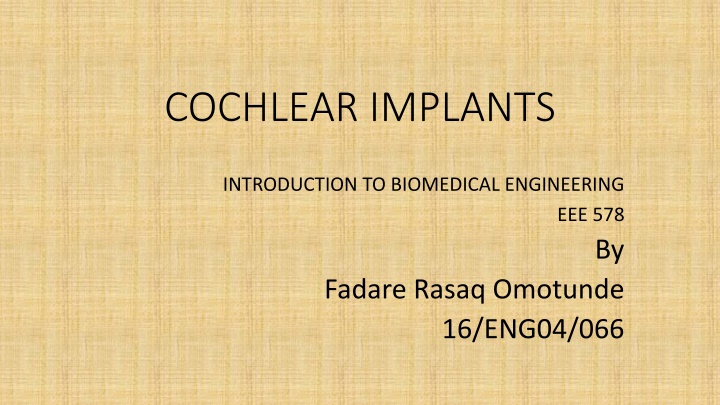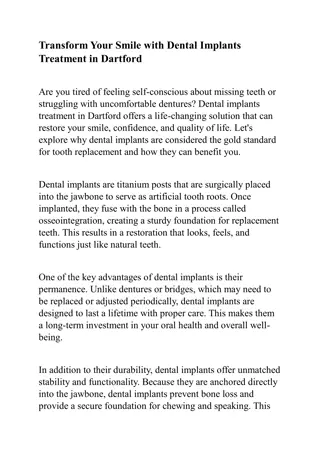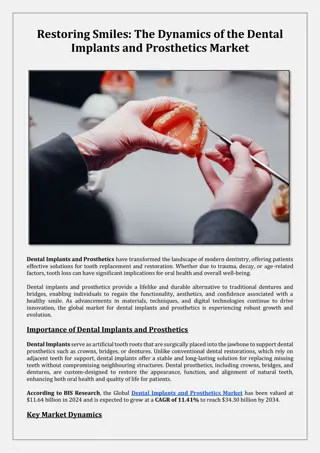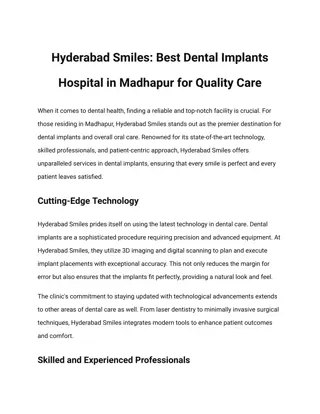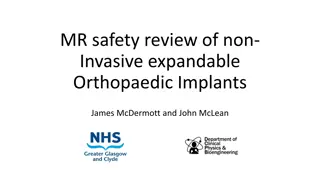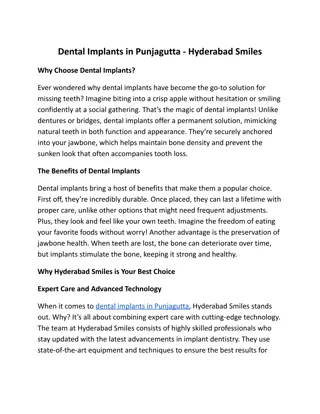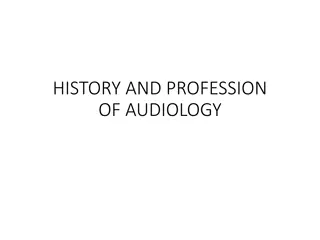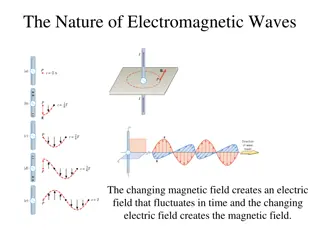COCHLEAR IMPLANTS
Cochlear implants play a crucial role in addressing sensorineural hearing loss, a condition affecting millions of individuals worldwide. This technology is especially beneficial for patients with profound hearing loss, enabling them to regain a sense of sound and improve their quality of life. By understanding the causes and implications of sensorineural hearing loss, we can better appreciate the significance of cochlear implants in the field of biomedical engineering.
Download Presentation

Please find below an Image/Link to download the presentation.
The content on the website is provided AS IS for your information and personal use only. It may not be sold, licensed, or shared on other websites without obtaining consent from the author.If you encounter any issues during the download, it is possible that the publisher has removed the file from their server.
You are allowed to download the files provided on this website for personal or commercial use, subject to the condition that they are used lawfully. All files are the property of their respective owners.
The content on the website is provided AS IS for your information and personal use only. It may not be sold, licensed, or shared on other websites without obtaining consent from the author.
E N D
Presentation Transcript
COCHLEAR IMPLANTS INTRODUCTION TO BIOMEDICAL ENGINEERING EEE 578 By Fadare Rasaq Omotunde 16/ENG04/066
Clinical need of cochlear implants According to the U.S. Census Bureau s Survey of Income and Program Participation, about 8 million children (aged 6 - 17 yr.) and adults in the United States in 2002 were deaf or hard of hearing. About 1 million of these individuals are functionally deaf. Each year, about one in every 1000 new-borns has congenital hearing loss. many of these cases are identified in hospitals and birthing centres. New-born hearing screening is typically conducted using optoacoustic emissions and/or auditory brainstem response testing before the infant leaves the hospital. 2
Sensorineural Hearing Loss When a problem with the outer or middle ear prevents sound from being properly conducted to the inner ear, the hearing loss is a conductive loss. In contrast, damage to the inner ear results in a sensorineural hearing loss. Cochlear implants are indicated for patients with sensorineural hearing loss whose hearing thresholds are 70-90 dB or poorer at 1000 Hz 3
Sensorineural Hearing Loss Congenital sensorineural hearing loss, or hearing loss present at birth, can be traced to many factors, with about 50% due to genetic mutations, 25% due to environmental factors, and 25% of unknown etiology. Environmental factors that lead to congenital hearing loss include cytomegalovirus, ototoxic medications, rubella, and other viruses. These factors may cause cochlear swelling and hair cell loss. Acquired sensorineural hearing loss is due to many factors, including aging, noise, ototoxicity, cardiovascular disease, hypoxia, bacterial and viral agents, and infectious disease. Very often the cause is unknown. 4
The Processor The microphone accepts sound in the range of 70 8500Hz and converts it to electrical signal, the electrical signal is sent to the digital signal processor (DSP) where its encoded for transmission, amplified and transmitted over radiofrequency of 12MHz at 0.6MB/s by the transceiver coil to the implant, the transceiver also receives electrode data and sends it to the DSP. 8
The Implant The transceiver coil in the implant receives the encoded signal, the received data parameters are decoded and used to construct the proper biphasic stimulation waveforms for selected channels. This circuit includes 24 current sources for 12 pairs of electrodes. The Concerto implant is hermetically sealed in titanium housing. An alternate Pulsar package for the same electronics is made from Al2O3. For the Concerto package, the reference electrode is part of the implant. 9
The Electrode Array Stimulation current is transmitted to the active electrode array. The electrode array is composed of single-strand platinum iridium wire and 24 platinum electrodes, encased in silicone rubber. The electrodes are arranged as paired interconnected surfaces, which result in 12 mono-polar stimulation channels. The inter-electrode spacing is 2.4 mm, across an active distance of 26.4 mm. The electrode array may be inserted up to 31 mm into the cochlea. 10
The Programmer Approximately 4 weeks after successful implant surgery, a patient receives the external processor. An audiologist uses fitting software and an interface box to connect a PC to the processor. Each channel is tested to ensure that it is electrically functional (neither a short or open circuit) and does not cause unpleasant nonauditory sensation such as dizziness or other facial nerve stimulation. For each viable channel, the threshold, T, and most comfortable loudness, C, levels are determined. 11
Key Features from Engineering Standards Standard: EN 45502-2-3 Active Implantable Medical Devices Part 2-3: Particular Requirements for Cochlear and Auditory Brainstem Implant Systems (BSI, 2010). Output Amplitude Immunity to MRI Effect of tensile forces Effect of direct impact Effect of atmospheric pressure 12
TYPES/MODELS OF COCHLEAR IMPLANTS Bone conduction implant (Bone Bridge) Manufactured by MED-EL Natural sound quality Placed fully under the skin Small and stylish audio processor Natural sound quality Placed fully under the skin 1.5 Tesla MRI without surgery 13
TYPES/MODELS OF COCHLEAR IMPLANTS Electric Acoustic stimulation (Synchrony 2 cochlea implant) Manufactured by MED-EL Easier to socialize with friends Improved communication with family members Better hearing in noisy settings, like restaurants Easier listening on the phone 14
TYPES/MODELS OF COCHLEAR IMPLANTS Bone conduction system (ADHEAR) Manufactured by MED-EL Effortless hearing (No surgery required) Reliable listening (Stays securely in place for optimal sound quality) All-day wearing comfort (No pressure on the skin) Sleek design (Easy to hide ADHEAR under hair) For all ages (Ideal solution for babies and toddlers) 15
CONCLUSION The invention of cochlear implants has been able to fully solve the problem of earing defects and deafness in humans. Modern cochlear implants have advanced features that include wireless pairing, Natural sound, wireless charging etc. Some of the new cochlear implants do not require surgery, the device is attached externally and is fully functional. 16
REFERENCES [1] G. Baura, Medical Device Technologies. 2012. [2] Hearing solutions. [Online]. Available: https://www.medel.com/en-us/hearing-solutions. 17
